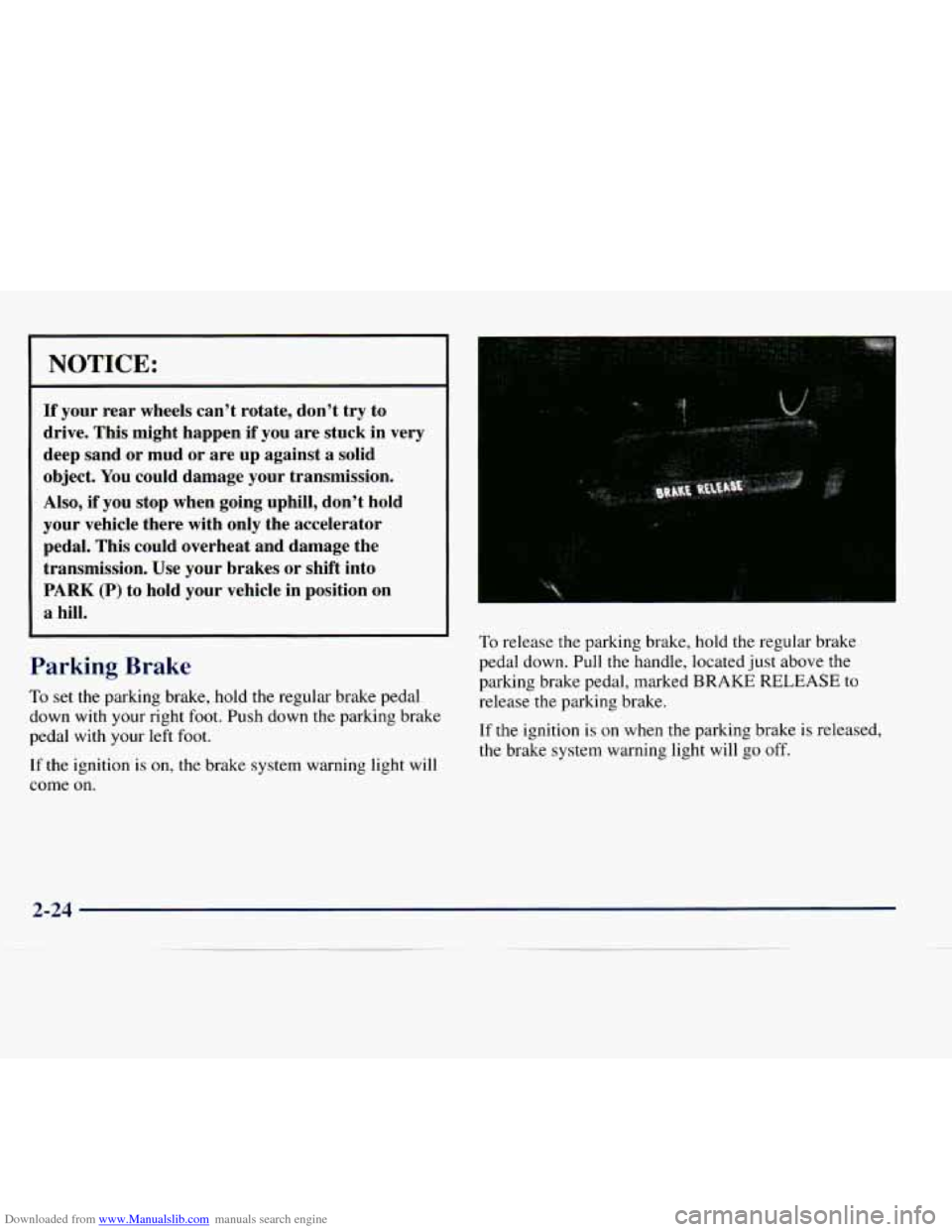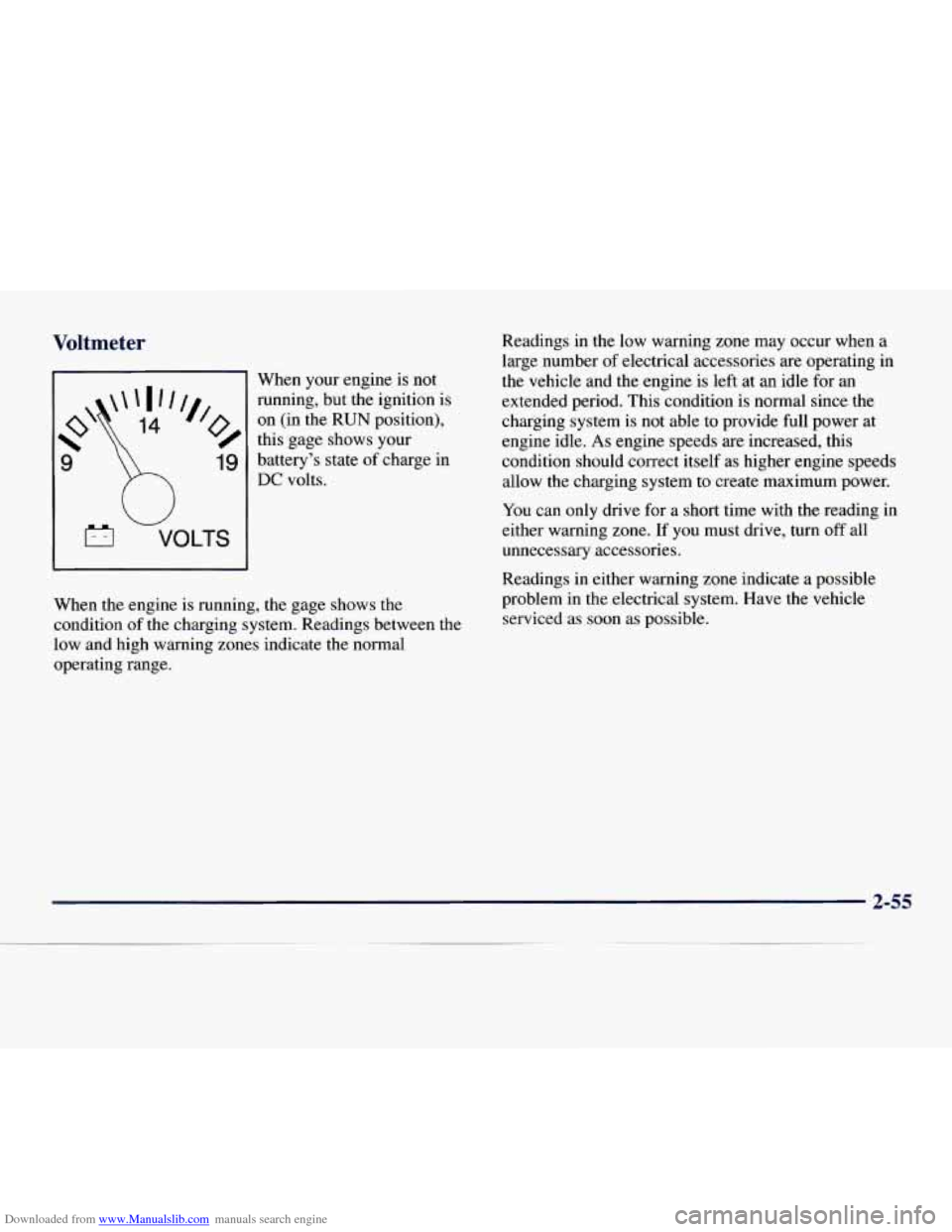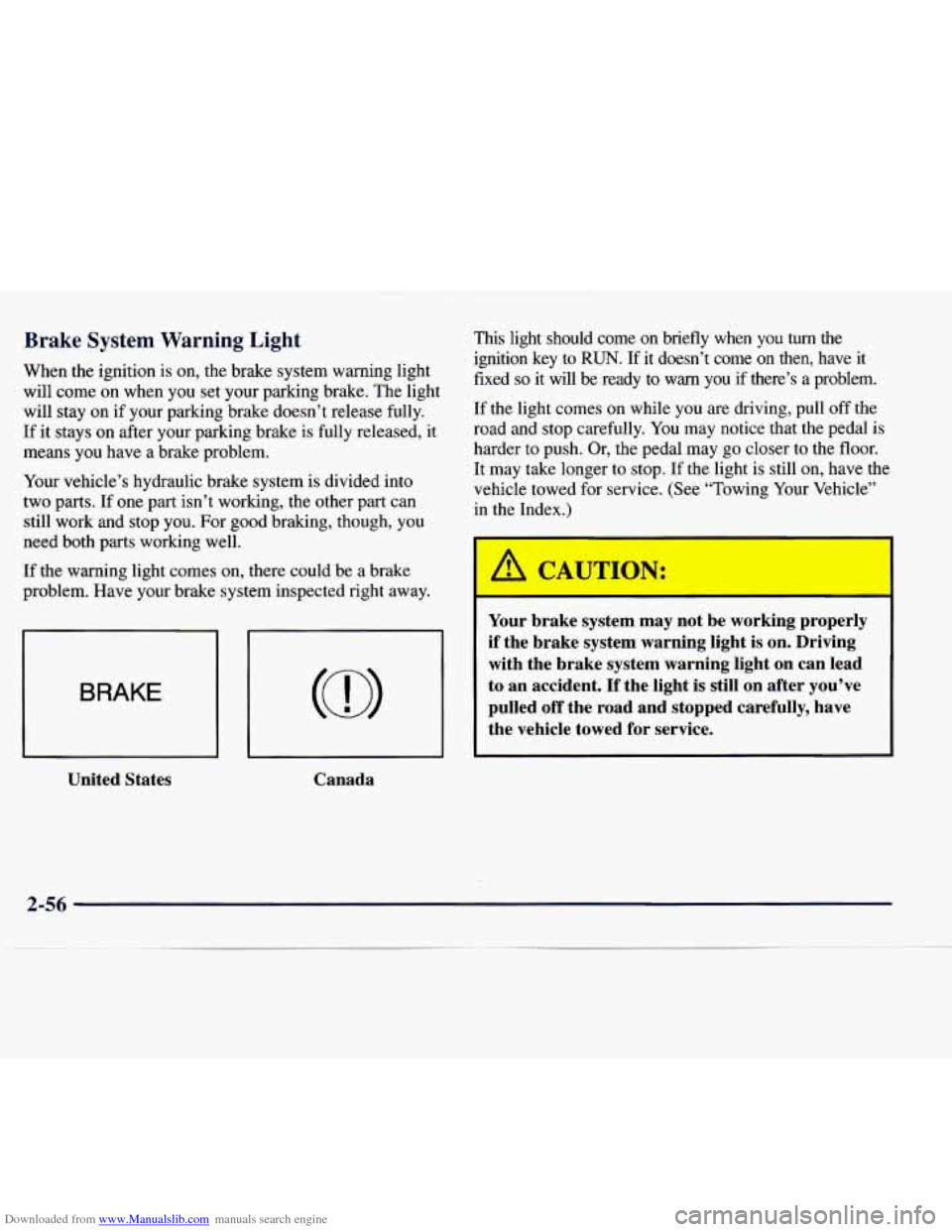1998 CHEVROLET EXPRESS warning
[x] Cancel search: warningPage 4 of 386

Downloaded from www.Manualslib.com manuals search engine How to Use this Manual
Many people read their owner’s manual from beginning
to end when they first receive their new vehicle. If you
do this, it will help you learn about the features and
controls for your vehicle. In this manual, you’ll find
that pictures and words work together to explain
things quickly.
Index
A good place to look for what you need is the Index in
back of the manual. It’s an alphabetical list of what’s in
the manual, and the page number where you’ll find it.
Safety Warnings and Symbols
You will find a number of safety cautions in this book.
We use a box and the word
CAUTION to tell you
about things that could hurt
you if you were to ignore
the warning.
I A CAUTION: I
These mean there is something that could hurt
you or other people.
In the caution area, we tell you what the hazard is. Then
we tell
you what to do to help avoid or reduce the
hazard. Please read these cautions.
If you don’t, you or
others could be hurt.
iii
Page 5 of 386

Downloaded from www.Manualslib.com manuals search engine You will also find a circle
with a slash through it in
this book. This safety
symbol means “Don’t,”
“Don’t do this” or “Don’t In the notice area, we tell you
about something that can
damage your vehicle. Many times, this damage would
not be covered by your warranty, and
it could be costly.
But the notice will tell you what to do to help avoid
the damage.
Vehicle Damage Warnings
Also, in this book you will find these notices:
NOTICE:
These mean there is something that could
damage your vehicle.
When you read other manuals, you might see
CAUTION and NOTICE warnings in different colors or
in different words.
You’ll also see warning labels on your vehicle. They use
the same words, CAUTION or NOTICE.
iv
Page 6 of 386

Downloaded from www.Manualslib.com manuals search engine Vehicle Symbols
These are some of the symbols you may find on your vehicle.
For example,
these symbols
are used on an
original battery:
POSSIBLE A
CAUTION
INJURY
PROTECT EYES BY
SHIELDING
CAUSTIC
ACID COULD
x
BATTERY
CAUSE
BURNS
AVOID
SPARKS
OR
FLAMES
SPARK
OR ,111,
COULD FLAME
EXPLODE BATTERY
These symbols are important
for you and
your passengers
whenever your
vehicle is
driven
:
DOOR LOCK
UNLOCK
FASTEN SEAT
BELTS
These symbols
have
to do with
your lamps:
SIGNALS e
TURN
WARNING
A
HAZARD
FLASHER
FOG LAMPS
$0
These symbols
are on some
of
your controls:
WINDSHIELD
WIPER
WINDSHIELD DEFROSTER
WINDOW
DEFOGGER
VENTILATING FAN
These symbols are used on
warning and
indicator lights:
COOLANT -
TEMP -
CHARGING BATTERY
SYSTEM
BRAKE
(a)
COOLANT a
ENGINE OIL
PRESSURE
Wh
ANTI-LOCK (@)
BRAKES
Here are some
other symbols
you may see:
FUSE -%-
I
LIGHTER
HORN
b
SPEAKER
b
FUEL p3
V
Page 72 of 386

Downloaded from www.Manualslib.com manuals search engine Section 2 Features and Controls
Here you can learn about the many standard and optional features on your vehicle, and information on starting,
shifting and braking. Also explained are the instrument panel and the warning systems that tell you if everything is
working properly
-- and what to do if you have a problem.
2-2 2-4
2-6
2-9
2- 15
2- 16
2- 17
2- 17
2-18
2-20
2-2 1
2-24
2-25 2-28
2-29
2-29 Keys
Door Locks
Keyless Entry System (If Equipped)
Your Doors and How They Work
Theft
Passlock@
New Vehicle “Break-In”
Ignition Positions
Starting Your Gasoline Engine
Engine Coolant Heater (If Equipped)
Automatic Transmission Operation
Parking Brake
Shifting Into PARK
(P)
Shifting Out of PARK (P)
Parking Over Things That Burn
Engine Exhaust 2-30
2-30
2-3
1
2-33
2-34
2-34
2-40
2-43
2-45
2-48
2-48
2-49 2-50
2-5
1
2-53 Running
Your Engine While You’re Parked
Locking Rear Axle (If Equipped)
Windows Horn
Tilt Wheel (Option)
Turn SignalMultifunction Lever
Exterior Lamps
Interior Lamps
Mirrors Storage Compartments
Cigarette LightedAshtray
Sun Visors
Instrument Panel
Instrument Cluster
Warning Lights, Gages and Indicators
Page 95 of 386

Downloaded from www.Manualslib.com manuals search engine NOTICE:
If your rear wheels can’t rotate, don’t try to
drive. This might happen if you are stuck in very
deep sand or mud or are up against a solid
object. You could damage your transmission.
Also, if you stop when going uphill, don’t hold
your vehicle there with only the accelerator
pedal. This could overheat and damage the
transmission. Use your brakes or shift into
PARK (P) to hold your vehicle in position on
a hill.
Parking Brake
To set the parking brake, hold the regular brake pedal
down with your right foot. Push down the parking brake
pedal with your left foot.
If the ignition is on, the brake system warning light will
come
on.
To release the parking brake, hold the regular brake
pedal down. Pull the handle, located just above the
parking brake pedal, marked
BRAKE RELEASE to
release
the parking brake.
If the ignition is on when the parking brake
is released,
the brake system warning light will
go off.
2-24
Page 124 of 386

Downloaded from www.Manualslib.com manuals search engine Electronic Road-Speed Governor (Gasoline Engines) (Option)
This optional system automatically controls vehicle top
speed. The system controller receives a signal from the
vehicle speed sensor and reduces power when the
vehicle speed reaches
the maximum 65 mph (105 kdh)
governed speed.
Warning Lights, Gages
and Indicators
This part describes the warning lights and gages that
may be on your vehicle. The pictures will help you
locate them.
Warning lights and gages can signal that something is
wrong before it becomes serious enough to cause an
expensive repair or replacement. Paying attention to
your warning lights and gages could also save you or
others from injury.
Warning lights come on when there may be
or is a
problem with one of your vehicle’s functions. As you
will see in the details on
the next few pages, some
warning lights come on briefly when
you start the
engine just to let you know they’re working. If you are
familiar with this section, you should not be alarmed
when this happens. Gages
can indicate when there may be or is a problem
with one
of your vehicle’s functions. Often gages and
warning lights work together
to let you know when
there’s a problem with your vehicle.
When one of
the warning lights comes on and stays on
when you are driving, or when one of the gages shows
there may be a problem, check the section that tells you
what to do about it. Please follow this manual’s advice.
Waiting to do repairs can be costly
-- and even
dangerous.
So please get to know your warning lights
and gages. They’re a big help.
Safety Belt Reminder Light
When the key is turned to RUN or START, a tone will
come on for about eight seconds to remind people to
fasten their safety belts, unless the driver’s safety belt is
already buckled.
The safety belt light will
also come on and stay on
for about
20 seconds, then it
will flash for about
55 seconds.
If the driver’s belt is already buckled, neither the tone
nor the light will come on.
Page 126 of 386

Downloaded from www.Manualslib.com manuals search engine Voltmeter
1 VOLTS I
W
When your engine is not
running, but
the ignition is
on (in the RUN position),
this gage shows your
battery’s
state of charge in
DC volts.
When the engine is running, the gage shows the
condition of the charging system. Readings between the
low and high warning zones indicate the normal
operating range. Readings in
the low warning zone may occur when a
large number
of electrical accessories are operating in
the vehicle and the engine is left at an idle for
an
extended period. This condition is normal since the
charging system
is not able to provide full power at
engine idle.
As engine speeds are increased, this
condition should correct itself as higher engine speeds
allow
the charging system to create maximum power.
You
can only drive for a short time with the reading in
either warning zone. If you must drive, turn off all
unnecessary accessories.
Readings in either warning zone indicate a possible
problem in the electrical system. Have the vehicle
serviced as soon as possible.
2-55
Page 127 of 386

Downloaded from www.Manualslib.com manuals search engine Brake System Warning Light This iiiht should come on briefly when you turn the
When the ignition
is on, the brake system warning light fixed so it will be ready to warn you if a problem.
will come
on when you set your parking brake. The light
will stay on if your parking brake doesn’t release fully.
If the light comes on while you are driving, pull off the
If it stays on after your parking brake is fully released, it road and stop Carefully. YOU may notice that the Pedal is
ignition key
to RUN. If it doesn’t come on then, have it
means you have a brake problem.
Your vehicle’s hydraulic brake system
is divided into
two parts.
If one part isn’t working, the other part can
still work and stop you. For good braking, though, you
need both parts working well.
If the warning light comes on, there could be a brake
problem. Have your brake system inspected right away.
BRAKE
United States Canada
harder to push. Or, the pedal may go closer to the floor.
It may take longer to stop. If the light is still on, have the
vehicle towed for service. (See “Towing Your Vehicle”
in the Index.)
I-
Your brake system may not be working properly
if the brake system warning light
is on. Driving
with the brake system warning light on can lead
to an accident.
If the light is still on after you’ve
pulled
off the road and stopped carefully, have
the vehicle towed for service.
2-56